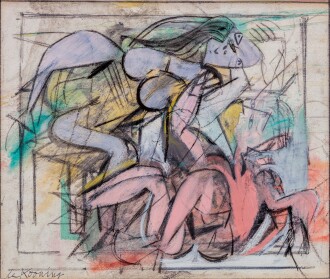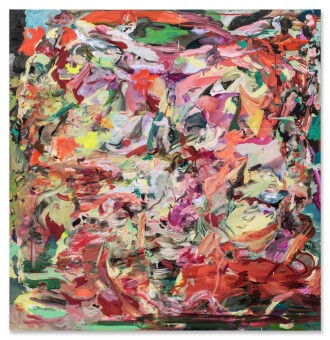The Rise of a Music Legend in Los Angeles
D espite the explosion of rock ’n’ roll in the late 1950s, Frank Sinatra, his cohort of Rat Packers and myriad imitators still dominated the American music scene. But Sinatra had been around long enough, riding high and sliding low, to know that real power came from managing and marketing music, not just making it. To that end, after a failed attempt to buy the prestigious label Verve, he launched Reprise in 1960. Artistic autonomy ruled and musicians owned their work. But the label was mainly populated by Sinatra’s friends and assorted crooners, and the hazy aura of glamor conferred by the Chairman of the Board’s patronage ensured that Reprise remained a small boutique traditional label.
Sinatra hated rock ’n’ roll. He saw it as the antithesis of his generation’s music, but by the 1960s even he couldn’t deny the future. With few younger acts, the label struggled financially. Sinatra may have missed these tectonic shifts in the entertainment industry, but he had hired a young man who, it seemed, could see into the future of music. Reprise’s label boss and Verve’s former controller was a man of vision and energy who would go on to shape the American rock music landscape over the next three decades while selling billions of albums worldwide. His name was Mo Ostin.
Warm, cultured, easy-going and a devoted fan of Sinatra, Ostin was passionate about music and art, musicians and artists. Over the years, he stood out from his rivals in the industry by being respected – loved, even – by his proteges and colleagues, many of whom became personal friends. He was, and remained until his retirement in the 1990s, a calm and steady presence in the tempestuous waters of the rock business. And his passionate championing of artists through turbulent periods meant that the superstars who worked with him – Neil Young, Madonna, Van Dyke Parks, Prince, Paul Simon – fondly acknowledged his honesty, integrity and respect for creativity.
Ostin’s ascent really took off when Warner Bros acquired Sinatra’s Reprise label in 1963, a move designed to seduce Sinatra into making movie scores. Warner-Reprise emerged under the joint management of Ostin and his counterpart at Warner, Joe Smith. Mo knew an emerging market of baby boomers would soon take hold of the record-buying public and bring with them new tastes.
“Mo was a hero. Supporting artists and their work all the way through his long life, Mo, the giant among record business leaders, backed us all up and let us do what we wanted with our music. … Without Mo, my life in music could never have been the same.”
Still, not everyone saw the writing on the wall. Ostin sat a recalcitrant Sinatra down and made the case for signing a new generation of artists to ensure the label’s longevity; it wasn’t an easy conversation. Sinatra’s attitude was prevalent at the time. In 1963 Los Angeles-based Capitol records was busy turning down future classics by The Beatles, sent from EMI, their parent label in the United Kingdom, despite the United Kingdom falling for the group's fresh sound with records such as “From Me to You,” “Please Please Me,” and “She Loves You,” as well as the wave of bands who soared in their slipstream such as The Rolling Stones, The Hollies and The Who. Ostin moved fast and, despite the Chairman of the Board’s grumbles, signed The Kinks, one of London’s most exciting young bands, who would go on to have six US Top 40 hits by the end of 1965.
A couple of years later, to the astonishment of his peers in the industry (and the delight of his sons and their friends), Ostin took a gamble on an electrifying young guitarist. Struggling to attract US label attention, Jimi Hendrix had moved to the UK to get noticed. After Ostin signed Hendrix, his debut LP Are You Experienced blasted to the top of the US charts. “When we saw Jimi perform at Monterey, everybody went nuts,” he told The LA Times in 1994. “I almost thought I was on Mars. You just knew it was a new world, a different artist. It wasn’t the same old singles business it used to be.”
With Hendrix on board as well as a burgeoning assortment of pop, rock, folk and esoteric artists on board, Warner-Reprise went from a marginal label to pioneers, and Ostin now sat at the frontier of the music industry. Springing from the vibrant beat pop of the early 1960s, Ostin went on to crest the decade’s forays into psychedelia, politically infused protest pop, folk-rock and singer-songwriters, all the way to heavy rock. And with a tight, like-minded creative clique around him – consisting of producer and Warner-Reprise VP Lenny Waronker and advertising copywriter Stan Cornyn – Ostin acquired and nurtured an enviable roster of artists.
“There weren’t many people like Mo Ostin around,” says Barney Hoskyns, whose book Waiting for the Sun charts the post-war LA music scene. Under Ostin and Smith’s stewardship, Warner-Reprise became “a little empire” in Burbank, California. “Capitol had some hip staffers, but the mark of a great record-company head was that you welcome change. You’re not alarmed by things that threaten the status quo.”
The same year Ostin signed Hendrix, he enthusiastically spent $80,000 on Van Dyke Park’s critically lauded commercial flop, Song Cycle. He also ran a series of droll ads, written by Cornyn, gently ribbing the public over their lack of enthusiasm. It was enough to make a mantra. Ostin gathered his colleagues and gave them his recipe for success: “Let’s stop trying to make hit records. Let’s just make good records and turn those into hits.”
“Warner-Reprise became identified with great taste and eccentricities,” says Hoskyns. “Mo was very happy with those bizarre ad campaigns Stan Cornyn planted in underground music mags, as they set Warner-Reprise apart from the music industry as we knew it. They had a sense of humor.”
In the 1970s Warner-Reprise became, simply, Warner Bros Records with Ostin at the helm. They went on to sell hundreds of millions of records, spanning the spectrum – from the obscure and absurd, through the sublime and, of course, the global blockbusters. As much as Ostin moved smash hits like Fleetwood Mac’s 1977 album Rumours, he also supported the wildly idiosyncratic Frank Zappa and cult acts like Tiny Tim. In the late 1980s he coaxed REM to Warner Bros and made the college-rock band into worldwide stars. Meanwhile, Ostin was so thrilled to work with Prince that he happily released whatever the Purple One delivered to the Warner’s offices at Burbank, where Prince would usually sing along as he played Ostin his latest work.
“Unlike other executives we talked to, Mo seemed genuinely interested in our music,” REM’s Mike Mills told The LA Times in 2022. “The best thing about him was that he seemed honest. So, we trusted him, and it paid off – in spades.”

Mo Ostin’s Love of Art
“This is a business of creativity and risk-taking and passion,” Ostin said when accepting an honor at a 2003 awards ceremony. “And, in the struggle between art and commerce, the artist must prevail.” This philosophy perfectly summarized Ostin’s love of fresh ideas, revolutionary thinking and indifference to commercial pressures at the expense of creativity. It was also reflected in his love of art.
Inspired by Steven J. Ross, his friend at the top of Warner Communications and a prolific collector, Ostin began seriously building his art collection in 1970. His collection – 33 works are headed to auction at Sotheby’s this May – echo some of the most significant junctures and positions of 20th- and 21st-century art. Visitors to his Burbank offices – nicknamed “The Chalet” for its abundance of warm wood, cozy sofas and intimate atmosphere – recall the Picasso prints whose skewed, utterly unique depictions of the world tuned in perfectly to Ostin’s own tastes.
And indeed, in the early 1960s Ostin was thrilled to secure a hand-written agreement for the great artist himself to create an animated film about Don Quixote for Warner Bros. The deal fell apart when senior colleagues got cold feet about the prospect of working with the notoriously unpredictable Picasso. “How could they pass up the chance to be involved with one of the true geniuses of the 20th century?” Ostin remarked with incredulity three decades later, speaking in a rare interview with The LA Times. “It was just incomprehensible to me. I mean, where were these guys at?”

“Mo’s love of art was second only to his love of music. He talked music and painting with the same fervor and perception, and he thrilled to any discussion of either.”
Art was woven into Ostin’s life since childhood, when he regularly visited museums with his parents. He also observed, and was deeply impressed by, the chairman of Clef Records (later Verve) Norman Granz’s focused and committed collecting in the 1950s and 1960s. Ostin went on to nurture fruitful relationships with the Allan Stone Gallery, Waddington Galleries in London, Robert Miller Gallery and Gagosian Gallery, as keenly as he did with his recording artists. Always hungry for a new discovery, and passionate about seeking out fresh ideas or historically significant moments, he read, learned and sought advice and perspectives – yet always followed his heart.
The Mo Ostin Collection that we see at Sotheby’s is a dynamic representation of artists across decades, showcasing Ostin’s unerring knack for identifying moments of genius. Fifteen works will appear in a dedicated auction on 16 May to kick off the season’s New York Sales, with eighteen to appear in The Contemporary Day Auction on 19 May.

Ostin’s earliest acquisitions in the 1970s include René Magritte’s L’Empire des lumières, a painting that especially beguiled him. In fact, Magritte’s crisp, vivid Surrealist visions were among Ostin’s favorites; he displayed L’Empire des lumières alongside another treasured Magritte, Le Domaine d’Arnheim. His love for the Belgian painter makes sense: Magritte had always believed music and Surrealism went hand in hand. Other artists in his collection, such as Willem de Kooning, Cecily Brown and Jean-Michel Basquiat, also included acoustic references in their work.

As the years went on, Ostin expanded his parameters from Modern masters such as Joan Mitchell, Cy Twombly and Willem de Kooning to discovering emerging painters; he owned significant works by Joe Bradley, Albert Oehlen, Lucas Arruda and Cecily Brown. Ostin enthusiastically kept up with new ideas and new artists, reveling in their audacity and spirit well into his 90s. Few record-company executives collected art with such care and personal enjoyment, but for Ostin, a man rarely photographed without a cheerful grin on his face, art was an exuberant part of the tapestry of life he so loved.
“Mo had a stunning art collection,” recalls Flea, bassist of The Red Hot Chili Peppers and a friend of Ostin’s. “He always took the time to teach me about the works. … Each piece lived in the context of art history as well as the arc of the artist’s particular career. Mo saw the best, knew what it was and acquired it.”
Friends recall Ostin’s unbridled joy when taking delivery of a new acquisition, his excitement and the careful deliberations over where in the house it would live in perpetuity. Each artwork was carefully sited to create dialogues between artists. Emblematic examples from 20th-century masters such as Picasso, Henri Matisse, Arshile Gorky, Roy Lichtenstein, Jasper Johns and John Marin were juxtaposed with contemporary works by artists such as Cecily Brown, Richard Prince, Takashi Murakami and Mark Grotjahn, the latter becoming a friend.
“He always took the time to teach me about the works. … Each piece lived in the context of art history as well as the arc of the artist’s particular career. Mo saw the best, knew what it was and acquired it.”
Mo Ostin and Evelyn, his wife, lived with his artworks, enjoying them daily. Visitors were often treated to tours and deep conversations about the work on the walls. In fact, Mo Ostin’s colleagues considered it a significant perk of working with Ostin and recalled the sheer pleasure of dining at the family's home. Ostin spoke proudly of his collection and the quirks, moments of beauty and surprises it contained. As author Peter Ames Carlin writes, “Sometimes Mo would bring a colleague home for dinner – maybe an executive from New York; maybe the furtive Van Morrison, off-balance and aloof, but not unfriendly. Joni Mitchell couldn’t keep her hands off the piano.”
Another friend and frequent guest was Steve Martin, a comedian with his own inimitable collection of art. Martin recalls Ostin’s passion fondly: “Mo’s love of art was second only to his love of music. He talked music and painting with the same fervor and perception, and he thrilled to any discussion of either.”
With characteristic modesty, Ostin never claimed to be a serious collector. But to cast an eye over his collection, assembled over 50 years, is to behold a celebration of extraordinary creativity. Over his career, Ostin sought artists who challenged convention, brought new ideas, created work that endured and knew how to alchemize the myriad elements of artistry to forge thrilling music. In his art collection, Ostin reacted to the same qualities.

Ostin retired from the music business in the late 1990s, devoting his time to philanthropic activities, especially at his beloved UCLA, where he established The Evelyn and Mo Ostin Music Center in 2014 and the Mo Ostin Basketball Center in 2017.
“He had class,” says Barney Hoskyns. “Mo was never a corporate raider; there was something very subtle and decent about him. He was a brilliant human being. And while he was the most respected executive in the music business for many years, I don’t think he was someone who wanted to be massively powerful and wealthy. He was a great man – we shall never see his like again.”
“The thing you’ve got to learn is to trust your instincts!” Ostin repeatedly told Warner employees and colleagues, musicians, friends and the beneficiaries of his and Evelyn’s many philanthropic activities. Ostin’s life is a lesson in just that. Today, he is regarded as ground-breaking, influential, creatively successful and beloved – just like the works of Prince or Picasso, Joni Mitchell or Magritte, Green Day or Mark Grotjahn that Ostin so loved and cherished with his eyes and ears, heart and soul.
Highlights from The Mo Ostin Collection
Banner: Ostin with Frank Sinatra during a recording session in 1967. Photo © Ed Thrasher / mptvimages.com






























